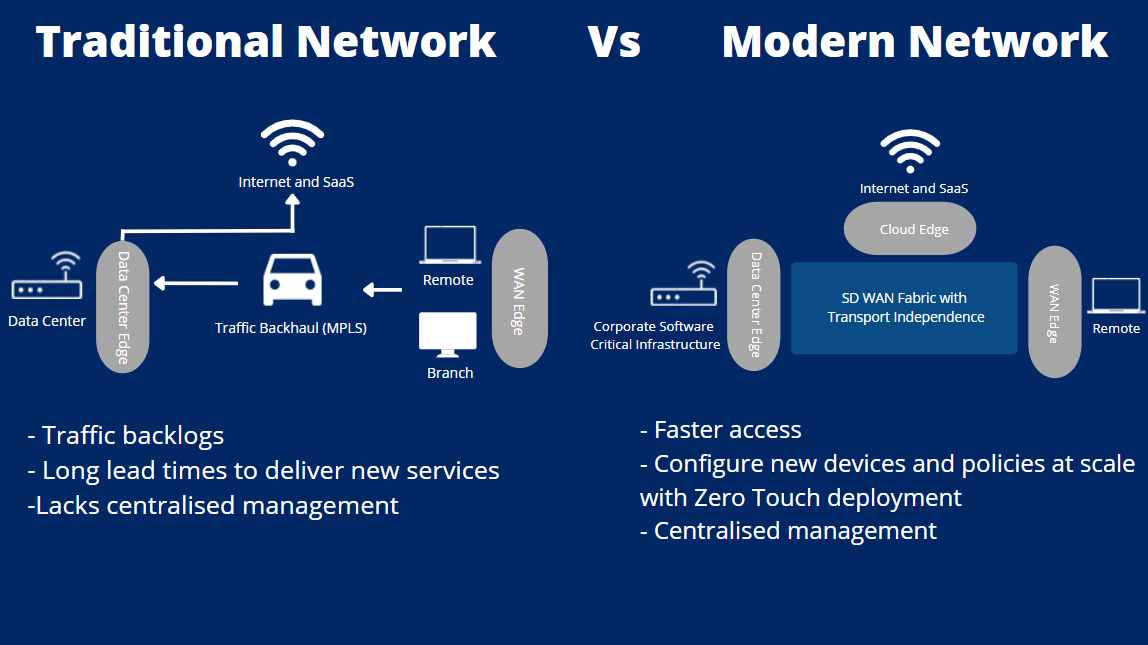Enterprise Networking
Enterprise Networking


Enterprise Networking
"The art of communication is the language of leadership." - James Humes, presidential speechwriter and author.
Welcome to the first edition of the BluBiz blog series, where we explore all things connectivity. Today, we're delving into enterprise networking and what it means for achieving business success.
What is Enterprise Networking?
An enterprise network of an organisation can be considered a private internet that's local to the organisation only. It consists of physical and virtual networks and protocols that allow users and systems to connect on a Local Area Network (LAN). These users and systems can then connect to applications in the data centre and cloud and facilitate access to network data and analytics. Multiple local computing devices are connected via switches, routers, ethernet or WiFi connections to share applications and data within this local network.
Enterprise networks, in short, are designed to:
- Connect a limited number of authorised systems, apps, and people.
Enterprise networking provides fast, secure, and reliable connectivity. Network administrators can also use enterprise networking solutions to view data centres, clouds, and network operations through a single pane. - Enable secure and efficient communication channels for business.
Perimeter and internal firewalls are designed to secure apps and data from outside attacks and are essential for enterprise networking.
The Key Components of Enterprise Networking
A traditional enterprise network consists of:
- Endpoints
o These include endpoint devices used by an organisation such as computers, laptops, mobile devices and servers. - Network devices
o Including repeaters, bridges, routers, switches, firewalls, storage, etc - Communications protocols
o A formal set of rules describing how to transmit or exchange data across the network. - LANs
o A Local Area Network connects systems within a small space or room. Large organisations within an enterprise network will implement a LAN for each department. - WANs
o A Wide Area Network covers a broader area than LAN set up for long-distance communication, which is secure and fast.

The Evolution of Enterprise Networking
The way enterprise networks are designed, delivered, and managed today has significantly changed over the past few years. A combination of cloud migration and new security challenges has brought innovation and positive changes to the traditional enterprise networking practices that are better suited to the needs of a modern business.
Today, employees are much more likely to:
- Connect to the network from inside and outside the office through:
o A hybrid cloud model.
o Connected exclusively to the cloud.
This makes a centralised networking infrastructure inefficient because the network becomes a bottleneck for traffic flowing to and from the cloud. In addition, many of the hardware appliances described above are now available as software or as virtualised cloud services.
As a result, an efficient, modern enterprise network architecture needs a distributed model where direct connectivity to the applications (via the Internet) can be provided without backhauling the traffic through the data centre. Additionally, security becomes paramount when accessing applications directly via the Internet. A new network security term was coined by Gartner, Secure Access Service Edge or SASE, to describe this new enterprise networking model.
SASE has allowed for:
- Tightly integrated security and network services.
- Security and network services to be no longer centralised in a handful of physical locations
- Any authorised person can connect from anywhere securely.
Lastly, the traditional network was hardware-centric. Modern networks, often called Software Defined Networks or SDN have since been introduced.
SDN operates by:
- Using programming and visualisations as its core offering.
- Improving network scalability and management via cloud-based network controllers.
The Importance Of Enterprise Networking and Its Benefits
Every enterprise needs a unique networking solution that supports the organisation's workflow, production processes, consumer demand, logistics, and more. With the right network tailored to organisational needs, an enterprise network can:
- Provide fast and reliable connectivity for end-users and applications, resulting in increased productivity through less downtime and better collaboration.
- Control access to the company's resources secured by perimeter and internal firewalls.
- Enable faster Moves, Adds and Changes (MACSs).
Things To Consider When Designing A Scalable, Secure and Manageable Enterprise Network
Constructing an enterprise network considering all the strategic needs of the business is highly critical but can be time-consuming. Some of the common pitfalls of not having an agile, scalable enterprise network in place are:
- Higher downtime
- Difficulty implementing security, reliability measures and scalability.
- Privacy issues
- Increased costs
- Long lead times for Moves, Adds and Changes (MACs)
A one size fits all approach does not work with enterprise networking. It's important to remember that the only way to build a scalable, secure and manageable enterprise network is to understand all options available and map the best with your business requirements and challenges.
BluBiz' Value Proposition
Enterprise networking has been the cornerstone of our core capabilities. We strongly believe that any digitisation objectives or digital transformation depends on the reliability of the network.
BluBiz Solutions has helped several organisations transform their legacy environments to a modern network that focuses on security, agility, reliability, scalability, and manageability. Some of our major clients include Catholic Network Australia with 1200 schools nationally, VMCH with more than 60 locations in Victoria, JG King Building Group, MSL, Yakult and many more.
We pride ourselves in bringing innovation and thought leadership to this critical part of ICT for any organisation. With our 25- 35 years of individual experience in the team and more than half a decade of delivering and managing modern networks, we feel privileged to share our learnings and expertise with businesses looking to take advantage of new advancements in this area.
From the initial consultation to planning, design, implementation and management, BluBiz offers end to end management and support in delivering enterprise networks for our clients.
Our 24x7 Network Operations Centre (NOC) provides proactive and real-time management of enterprise networks, increasing the uptime for our clients.
We are vendor agnostic and work with all major network and technology providers, including Cisco, Fortinet, VMWare and Palo Alto. We also work with all major telcos and service providers, including Telstra, Vocus, Optus and TPG, which allows us to help you tailor your solution to your business and goals.
With a forward-thinking approach to SDWAN, SASE and risk-free network migration, our experts are ready to help you achieve your goals.
If you're at the crossroads of making decisions regarding your networking solution requirements, we'd be delighted to share our experience and expertise to help you make the right choices.Please get in touch with one of our friendly team members to discuss your requirements.
